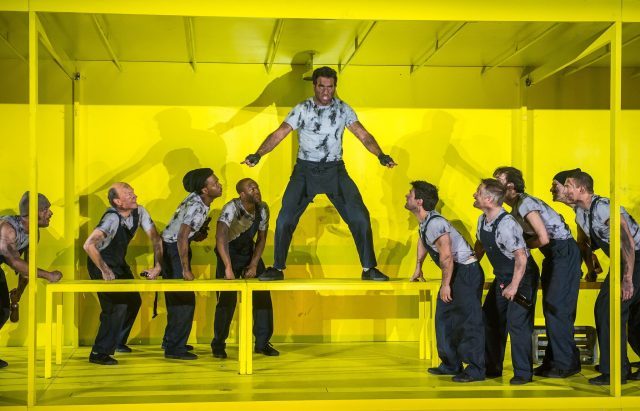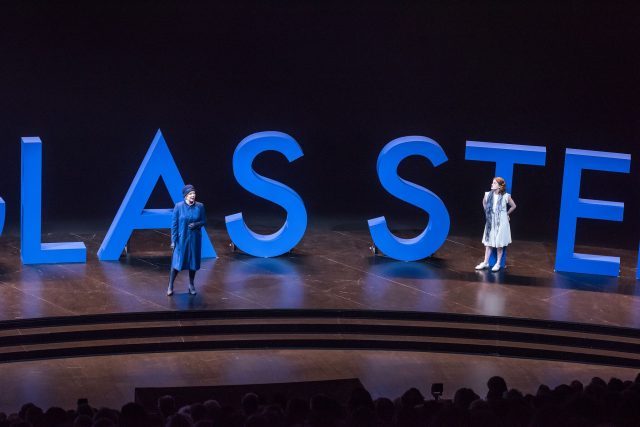
Robert “Yank” Smith (Bobby Cannavale) asserts himself in Richard Jones’s fierce revival of Eugene O’Neill’s THE HAIRY APE (photo by Stephanie Berger)
Park Ave. Armory, Wade Thompson Drill Hall
643 Park Ave. at 67th St.
Tuesday – Sunday through April 22, $60-$195
212-933-5812
www.armoryonpark.org
If it’s subtlety you’re looking for, you won’t find it in Eugene O’Neill’s 1922 play, The Hairy Ape, which continues through April 22 at the Park Avenue Armory in a grunting, ferocious production imported from the Old Vic. Written shortly after he won two Pulitzer Prizes (for Beyond the Horizon and Anna Christie), The Hairy Ape is O’Neill’s clarion call against capitalism, classism, socialism, slavery, and even ageism, focusing on the role of each unique person in contemporary American society. “I have tried to dig deep in it, to probe in the shadows of the soul of man bewildered by the disharmony of his primitive pride and individualism at war with the mechanistic development of society,” he said of his first draft of the play, which was partially inspired by the suicide of a friend of his, a stoker named Driscoll. Bobby Cannavale is fierce as Robert “Yank” Smith, a brute of a man who is the ersatz leader of a group of men working in the stokehole of an ocean liner, feeding coal to the fires to keep the vessel moving. Stewart Laing’s eye-opening conveyor-belt set rotates on a revolving, slightly elevated strip, half of which is in front of the audience, half of it behind. The men work in a long but not very high rectangular bright-yellow metal container that is open on one side, with two locked entrances at the end, one barred, as if they’re animals in a cage. Covered in black soot that looks like it will never come off, the men sing and play rough in drunken camaraderie, fully aware of their dank and dreary situation. “T’hell wit home. Where d’yuh get dat tripe? Dis is home, see?” Yank says in his tough New York City accent. A tipsy Long (Chris Bannow) rages, “Listen ’ere, Comrades! Yank ’ere is right. ’E says this ’ere stinkin’ ship is our ’ome. And ’e says as ’ome is ’ell. And ’e’s right! This is ’ell. We lives in ’ell, Comrades — and right enough we’ll die in it.” Old Paddy (David Costabile) remembers how things once were, when the men intertwined with nature, aboard clippers, working in the fresh air and sunshine. “’Twas them days men belonged to ships, not now,” he says. “’Twas them days a ship was part of the sea, and a man was part of a ship, and the sea joined all together and made it one.” But Yank is having none of that. “I belong and he don’t. He’s dead but I’m livin’,” he declares about Paddy. “Listen to me! Sure I’m part of de engines! Why de hell not!” Later, when the stokers are hard at work with their shovels, Mimi Jordan Sherin’s dazzling lighting, filled with ever-changing primary colors, turns the container red, as if the men are trapped in the fiery furnaces of hell itself.

Rich kid Mildred Douglas (Catherine Combs) tells her aunt (Becky Ann Baker) that she’s planning on visiting the stokers working down below (photo by Stephanie Berger)
Meanwhile, Mildred Douglas (Catherine Combs), the twenty-year-old heiress to the steel company for whom the stokers toil down below, is on the promenade deck of the ship, with her aunt (Becky Ann Baker). Dressed in white, Mildred walks through the oversized sans serif logo of her father’s company as she tells her aunt that she has arranged to go meet the men. The rich Mildred believes she can help them, make their lives better, but she also sees them merely as animals. “When a leopard complains of its spots, it must sound rather grotesque,” she says in a mocking tone. “Purr, little leopard. Purr, scratch, tear, kill, gorge yourself and be happy — only stay in the jungle where your spots are camouflage. In a cage they make you conspicuous.” Her visit doesn’t go very well — Yank can’t tell if she’s an angel or a ghost — but she awakens something deep inside him; he starts considering who he really is and where he truly belongs, leading to a string of absurdist adventures in New York City.

Stewart Laing’s sculptural sets and Mimi Jordan Sherin’s colorful lighting look stunning in Park Avenue Armory (photo by Stephanie Berger)
O’Neill pulls no punches in the play, pitting rich vs. poor, heaven vs. hell, old vs. young, male vs. female, and the concept of “clean” vs. “dirty.” His stage notes compare the men’s camaraderie to “the bewildered, furious, baffled defiance of a beast in a cage” and calls them “chained gorillas.” Cannavale (Boardwalk Empire, The Motherfucker with the Hat) is explosive as Yank — a role previously played onstage by Paul Robeson and Willem Dafoe and on the silver screen by William Bendix — whether taking a moment and posing as Rodin’s “Thinker” or pounding his chest, expressing his mental and physical superiority. The container can’t contain him; when Yank does venture out, Laing’s objects disappear and instead Yank is faced with a large, dark, unknown space, as Olivier Award–winning theater and opera director Jones (Too Clever by Half, The Illusion) takes full advantage of the massive Wade Thompson Drill Hall while adding surreal elements. In addition, composer Sarah Angliss contributes an immersive sound design, making the audience feel as if it is trapped as well. Not everything works; for example, the face of Mildred’s father shows up in a few strange places, and it probably wasn’t necessary. Costabile excels as Paddy, waxing poetic as he drinks himself into oblivion. The cast also includes Cosmo Jarvis as a prisoner, Mark Junek as the second officer, Henry Stram as a socialist secretary, and Tommy Bracco, Emmanuel Brown, Nicholas Bruder, Jamar Williams, and Amos Wolf as stokers. (It would be unfair to give away who Phil Hill portrays.) The play features existential movement by choreographer Aletta Collins (Anna Nicole, La Traviata) and dance captain (and ensemble member) Isadora Wolfe, starts and stops that are curious but effective. The seats, arranged in rising rows against the east wall of the drill hall, are all bright yellow, matching the container, making the audience complicit in O’Neill’s marvelous manipulations. The word “yellow” is used several times in the play, primarily representing the fear that lies in the heart of humanity, particularly when it’s up against dehumanizing industrial progress; Yank calls both Long and Paddy yellow, as well as the unseen engineer blowing a whistle that means the men have to get back to work. “He ain’t got no noive. He’s yellow, get me?” Yanks says. “All de engineers is yellow. Dey got streaks a mile wide. Aw, to hell wit him!” The Hairy Ape might not be one of O’Neill’s most popular plays — although he thought it was his best — but it’s a treat to see it in such a dazzling, unpredictable version, powered by a bold and brutal lead performance.